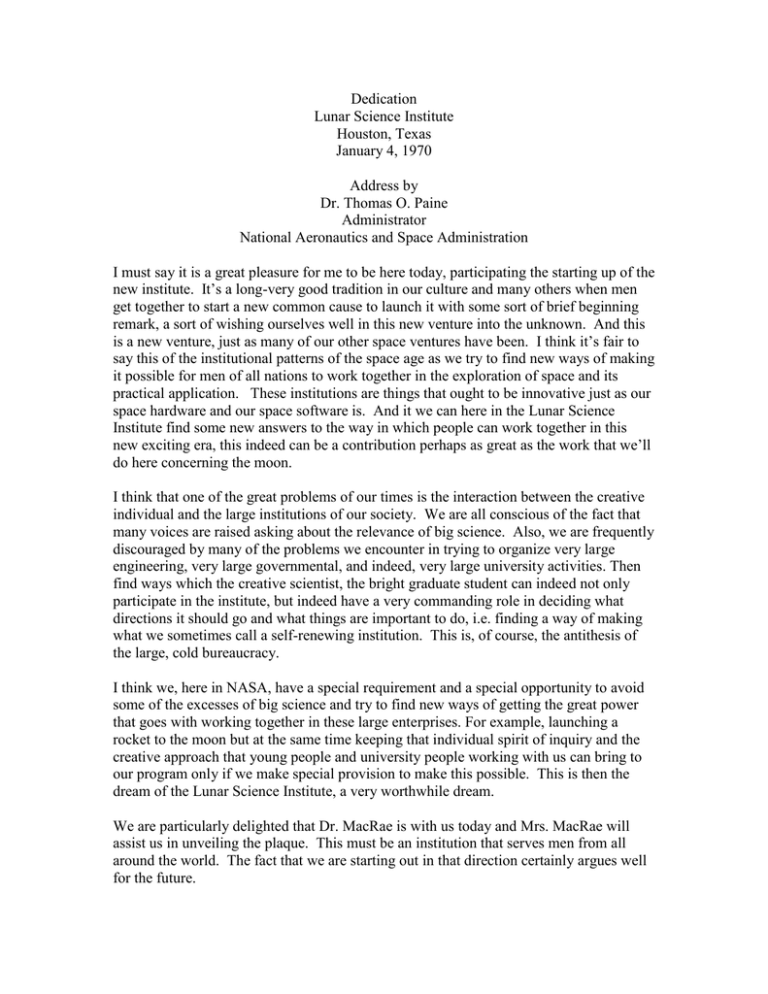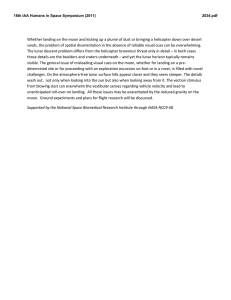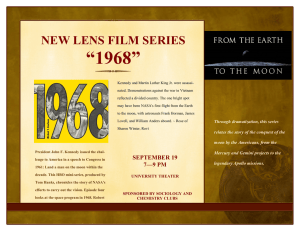Dedication Lunar Science Institute Houston, Texas January 4, 1970
advertisement

Dedication Lunar Science Institute Houston, Texas January 4, 1970 Address by Dr. Thomas O. Paine Administrator National Aeronautics and Space Administration I must say it is a great pleasure for me to be here today, participating the starting up of the new institute. It’s a long-very good tradition in our culture and many others when men get together to start a new common cause to launch it with some sort of brief beginning remark, a sort of wishing ourselves well in this new venture into the unknown. And this is a new venture, just as many of our other space ventures have been. I think it’s fair to say this of the institutional patterns of the space age as we try to find new ways of making it possible for men of all nations to work together in the exploration of space and its practical application. These institutions are things that ought to be innovative just as our space hardware and our space software is. And it we can here in the Lunar Science Institute find some new answers to the way in which people can work together in this new exciting era, this indeed can be a contribution perhaps as great as the work that we’ll do here concerning the moon. I think that one of the great problems of our times is the interaction between the creative individual and the large institutions of our society. We are all conscious of the fact that many voices are raised asking about the relevance of big science. Also, we are frequently discouraged by many of the problems we encounter in trying to organize very large engineering, very large governmental, and indeed, very large university activities. Then find ways which the creative scientist, the bright graduate student can indeed not only participate in the institute, but indeed have a very commanding role in deciding what directions it should go and what things are important to do, i.e. finding a way of making what we sometimes call a self-renewing institution. This is, of course, the antithesis of the large, cold bureaucracy. I think we, here in NASA, have a special requirement and a special opportunity to avoid some of the excesses of big science and try to find new ways of getting the great power that goes with working together in these large enterprises. For example, launching a rocket to the moon but at the same time keeping that individual spirit of inquiry and the creative approach that young people and university people working with us can bring to our program only if we make special provision to make this possible. This is then the dream of the Lunar Science Institute, a very worthwhile dream. We are particularly delighted that Dr. MacRae is with us today and Mrs. MacRae will assist us in unveiling the plaque. This must be an institution that serves men from all around the world. The fact that we are starting out in that direction certainly argues well for the future. In introducing me today, Dr. Wall very kindly stated that is was nice to have the Administrator of NASA here today and I must privately tell you how nice it is for me to be here. Earlier this week, I had the very difficult duty of reaching a decision that we would have to terminate one of our NASA center in Massachusetts. This is a center that we have all developed a great deal of affections and hard work to bringing in and yet with the current budget situation, we found it necessary to terminate this activity. It’s a much more pleasant task to be here today to start out a new enterprise and the thought that was going through my mind was, “What do you suppose will be the lifetime of this new institute, this new enterprise that we’re joining here together to start out?” I would hazard guess that it may have a very, very long lifetime indeed. In fact, I would like tot think that we’re starting something here today that as it evolves and unfolds, as we keep it changing and renewing itself, can indeed cast a very long shadow in the future. Man in this year has really only begun his intensive exploration of the Moon, His intensive exploration of the terrestrial bodies, his real search for some of the keys of the past, and I think also, a real search for the future and destiny of mankind in the future. This is the Institute that we are starting in a modest and small way this afternoon to help us to bring all of the kinds of expertise that we need, together to work in the common cause. I can thing of really nothing more exciting that this great adventure that this institute is starting out on. I envy Bill Rubey – the opportunity that he has to put some of his personality into this – and I want to certainly assure him that he will have the absolute full support for anything at all that he needs that we can provide to help make this a success. We do not want it just to be a success in the lunar sense alone. I think that all of us have the feeling that this Institute should also be somewhat of a pioneer in the general area of the interaction between scientists, government, and universities with the kinds of R&D that we can do working together. These questions of the engineering content of our program, the science content; the question of American, Canadians, Europeans, and Japanese, the many things that we are gong to have to do in the 1970’s must integrate together if we are going to realize the full potential of the space program. We, on our side in the NASA side, are looking forward with a good deal of optimism, to the things that together we can do. So, my greetings this afternoon are that we’re stating on something here that has a tremendous potential. All of us wish is well. I’m sure we can all work together in ways that will make this a model of the way in which science and government and universities and people from all around the world can create new institutions when they’re needed. Then mold those institutions and evolve them in ways that will make it possible for us all, together, to move ahead into this era of the exploration and application of space. It is now a great pleasure to proceed with the actual unveiling of the plaque that will symbolize the opening of the new Lunar Science Institute here in Houston. This institute is one which all of us have great hopes. We believe that this is the start of a new era in the exploration of the Moon. The way in which we organize to make it possible for men from all around the world to work together to get the absolute maximum of new scientific information from the work that goes on across the fence in our Manned Spacecraft Center here in Houston. It is important that we recognize that this event is happening after only a year from the time the first me traveled out to the Moon, and only six months from the time the first men made the landing. Already we have been able to start the flow of scientific data, have a much higher order of detail with very exciting kinds of things pouring into the data banks here which this institute will make it possible to explore thoroughly. We hope to find the answers to many of the mysteries about the Moon, which our work to date has opened up. In fact, I think if there’s one thing characteristic of not only the work that has been done so far on the Moon, but to science in general, it’s the fact that as we are able to answer old questions, invariably, new one develop, and so it’s proving with the Moon. We’re looking forward, staring tomorrow, to the first conference to begin to sift through what we’ve learning from Apollo 11. Of course, we have the Apollo 12 data coming in that’s giving us some new insight on the meaning of some of the things that were rather baffling in 111. Also, Apollo 12 had caused us to slow down a little bit and take another look at some of the things we though we were beginning to understand in 11. So this is a very exciting time, and it’s very appropriate then that we not unveil the plaque and officially open this new Lunar Science Institute here in Houston. Mrs. MacRae, if you would do the hours. This is a replica of a plaque, which is now being cast, and I’ll read it for those of you in the background. “The Universities Space Research Association The Lunar Science Institute Dedicated to the scientists of the earth who seek to understand the nature, origin and history of our Solar System January 4, 1970.”




